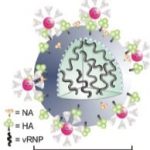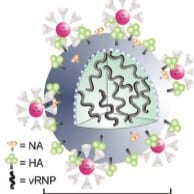 Functionalized gold nanoparticles are used to prevent flu viruses from attaching to and entering cells, in research by German scientists.
Functionalized gold nanoparticles are used to prevent flu viruses from attaching to and entering cells, in research by German scientists.
Influenza, or flu, is caught by hundreds of millions of people globally every year. It causes many lost working hours for employers, and can be fatal in those with weak immune systems, the young and the elderly. Because the flu virus can mutate so quickly, vaccination is often one step behind and flu can quickly develop resistance to current antiviral drugs, which generally work by inhibiting the un-coating of the virus prior to it delivering its contents into the host cell.
Now a German team based in Berlin and Giessen and led by Rainer Haag at Free University of Berlin has demonstrated a different approach. They functionalized gold nanoparticles with a dendrimer based on polyglycerol and covered with sialic acid, which occurs on the outside of the host cells and acts like a flag for the virus to recognise and bind to the cells. All flu viruses contain specific receptors to sialic acid, so viral mutation should not affect the efficacy of the binding.
Gold nanoparticles are known to be good drug delivery vehicles and carriers for binding sites. Vincent Rotello, who also works on the therapeutic use of gold nanoparticles at University of Massachusetts, Amherst, USA says “One of the things that nanoparticles do best is to provide scaffolds for multivalent interactions.” Because the nanoparticles can carry many copies of a binding ligand, therapeutically poor drugs can be given much higher activity if used in this way. Functionalized gold nanoparticles have already been exploited to inhibit some other viruses, but never flu.
The researchers worked with two different sizes of gold nanoparticles, and found that the larger nanoparticles were much better at preventing infection than the smaller ones. Rotello says “These results suggest that multivalency is key to binding the virus, with the larger particle presenting ligands over a wider area.” This disparity could be because the smaller particles present the ligands at spacing quite different from that of the virus receptors, so good binding cannot occur. The researchers believe the approach can still be improved by optimizing the ligand spacing and the flexibility of the dendrimer. What’s more, cells had a much better chance of surviving in the presence of these larger functionalized particles and the flu virus than with flu virus alone, which demonstrates the biocompatibility and real-life usefulness of the approach.
The researchers believe that their study will guide optimization of dendrons of this sort for antiviral properties. Cures for viruses like HIV, Herpes simplex, and influenza could be brought much closer using such strategies. So, when you next catch flu, consider reaching for the functionalized gold nanoparticles instead of the hot lemon and honey.

















